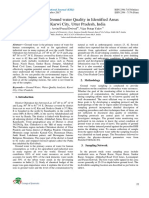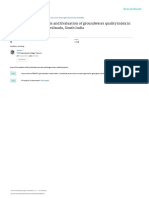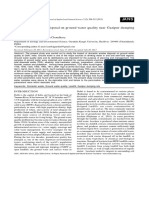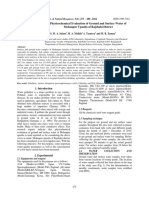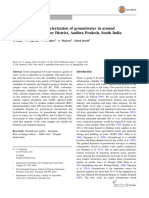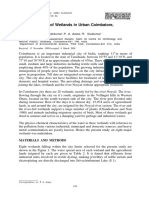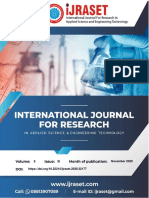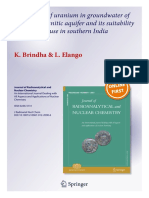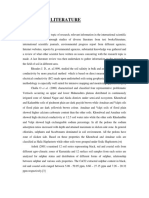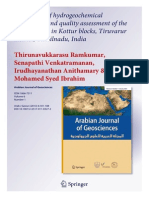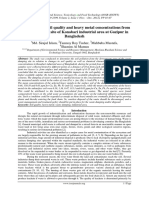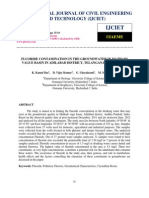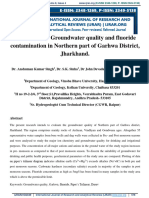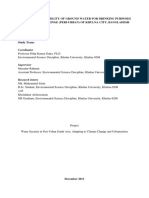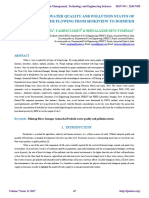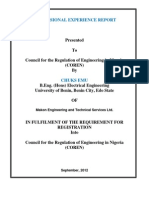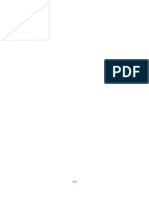Professional Documents
Culture Documents
Hydrochemical Study of Groundwater Qualities of Some Areas of Imphal West District of Manipur, India
Copyright
Available Formats
Share this document
Did you find this document useful?
Is this content inappropriate?
Report this DocumentCopyright:
Available Formats
Hydrochemical Study of Groundwater Qualities of Some Areas of Imphal West District of Manipur, India
Copyright:
Available Formats
Volume 8, Issue 3, March – 2023 International Journal of Innovative Science and Research Technology
ISSN No:-2456-2165
Hydrochemical Study of Groundwater Qualities of
Some Areas of Imphal West District of
Manipur, India
Dr. Nandababu Singh Laishram*
Associate Professor (Inorganic Chemistry)
Department of Chemistry
D.M. College of Science, Imphal – 795001, Dhanamanjuri University, Imphal
* Corresponding Author’s
Abstract:- Fifteen groundwater samples were collected I. INTRODUCTION
from three villages namely Kanglatongbi, Awang Sekmai
and Tengdoyan of Imphal West district of Manipur As the population growth increases day by day all
during pre-monsoon period(May) of 2018. They were over the world, rate of urbanization and hence extension of
analyzed for physico-chemical parameters such as urban areas also increase to accommodate increasing
temperature, pH, TDS (total dissolved solids), electrical population growth[1]. Consequently many surface water
conductivity(EC), total alkalinity(TA), CO32-, HCO3-, bodies sites are also losing to a large extent due to
total hardness (TH), Ca2+, Mg2+, Na+, K+ and Cl-. The construction of residential houses / buildings, office
values/concentrations of the different physico-chemical buildings, institutions, commercial areas etc. As a result of
parameters for the fifteen groundwaters were found to such urbanization and expansion of urban areas, there is
be below/ within the acceptable limits / recommended scarcity of surface water which is mainly required for
values of BIS standard for drinking water as well as that drinking (after proper treatment), other domestic, irrigation
of WHO. Thus all the fifteen groundwaters were found (or agriculture) and industrial purposes. As an impact of
to be suitable for drinking from physico-chemical such shortage of surface water for human needs, there is a
analysis point of view. However this does not guarantee great demand for groundwater for drinking, other domestic,
that such groundwaters are 100%, safe for drinking as irrigation (or agriculture) and industrial purposes.
there is need for investigations on some heavy metals
such Fe, As, Pb, Cd, Hg etc. and microbiological analysis Groundwater is about 0.6% of the total global water
of such groundwaters. Such groundwaters were found to resources and out of it, only 0.3% is extractable
be suitable for other domestic and irrigation purposes. economically[2]. It should not be taken for granted that such
Further, strong positive correlations of total hardness ground waters are always safe for drinking, irrigation and
with Ca2+, Na+, Cl- and moderately positive correlation industrial purposes. Their qualities have to be monitored
between total hardness and Mg2+ were indicative of the from time to time in order to examine whether they are fit
fact that the total hardness of the fifteen groundwaters for drinking, other domestic, irrigation and industrial
were mainly due to the presence of dissolved chlorides of purposes just like that of surface water. Therefore many
Ca2+, Mg2+ and Na+. Again correlation coefficient data researchers of different countries had carried out
indicated that Ca2+, Mg2+, Na+ and K+ were present investigations on the qualities of groundwaters not only the
mostly in the from of chlorides but to a lesser extent, as surface waters in order to examine whether they are fit for
bicarbonates in the fifteen groundwaters. drinking, other domestic and irrigation purposes mainly [3-
7]. Similarly, in India also, many researchers had carried out
Keywords: Physico-Chemical Parameters, Drinking, extensive researches on the qualities of ground waters
Domestic, Irrigation, BIS And WHO. besides investigation on the qualities of surface waters from
time to time so as to examine whether such groundwaters
not only the surface waters, are fit for human consumption
including other domestic and irrigation (or agricultural)
purposes mainly [8 – 14].
The present aim /objective of the research work is to
carry out hydrochemical study of groundwater qualities of
some areas of Imphal West district of Manipur so as to
examine whether such groundwaters are fit for drinking,
other domestic and irrigation purposes mainly.
IJISRT23MAR1384 www.ijisrt.com 1545
Volume 8, Issue 3, March – 2023 International Journal of Innovative Science and Research Technology
ISSN No:-2456-2165
II. MATERIAL AND METHOD
Study Area:
Altogether three villages of Imphal West district namely (i) Kanglatongbi (ii) Awang Sekmai and (iii) Tengdoyan, were
selected as most of the people of these villages are very much dependant on groundwater for drinking, other domestic and
agricultural purposes. Samples were collected from fifteen (15) different sampling sites of these three villages. The different
sampling sites alongwith their geographical locations (longitudes and latitudes) are detailed in table-1 below.
Table 1 Locations of Different Groundwater Samplings Sites
Sample Code (with source) Sampling sites Longitude Latitude
S-1 (Dug well) Tengdoyan Makha Leikai(1) 93052/57//E 24054/37//N
S-2 (Dug well) Awang Sekmai Nongthombam Leikai 93052/52//E 24057/37//N
S-3 (Dug well) Kanglatongbi Tispari(1) 93052/32//E 24057/58//N
(Bhakta Bahadur Karki’s residential area)
S-4 (Dug well) Kanglatongbi Tispari (2) 93052/31//E 24058/0//N
(Near Dilip Poudel’s residential gate)
S-5 (Dug well) Kanglatongbi Tispari(3) 93052/29//E 24058/2//N
(Krishna Prasad Champagain’s residential area)
S-6 (Dug well) Kanglatongbi Tispari (4) 93052/30//E 24058/3//N
(Khadka Bahadur Thapa’s residential area)
S-7 (Dug well) Kanglatongbi Tispari (5) 93052/29//E 24058/10//N
(Ramesh Upprety’s residential area)
S-8 (Dug well) Tengdongyan Makha Leikai (2) 93052/59//E 24054/43//N
S-9 (Dug well) Kanglatongbi Tispari (6) 93052/36//E 24057/49//N
(Moirangthem Inao’s residential area)
S-10 (Dug well) Kanglatongbi Tispari (7) 93052/28//E 24058/18//N
(Mr. Sanjit Thapa’s residential area)
S-11 (Dug well) Kanglatongbi Tispari (8) 93052/36//E 24058/17//N
(Near Nandalal Ranjali\s residential area)
S-12 (Dug well) Kanglatongbi Tispari(9) 93052/40//E 24058/18//N
(Front of Narmada Ghimraj’s residential area)
S-13 (Dug well) Kanglatongbi Tispari (10) 93052/45//E 24058/20//N
(Near Kewali Bista’s residential area)
S-14 (Dug well) Kanglatongbi Tispari (11) 93052/29//E 24058/20//N
(Santosh Budathoki’s residential area)
S-15 (Dug well) Kanglatongbi Tispari (12) 93052/23//E 24058/23//N
(Rajesh Baskota’s residential area)
Analysis Of Groundwater Samples:
The chemicals were of AR grade and were used as received. Chemicals used were HCl, NaOH, phenolphthalein indicator,
methyl orange indicator, Eriochrome Black T indicator(EBT), murexide indicator, disodium salt of EDTA, NH4OH,
MgSO4.2H2O, NaCl, NH4Cl and K2CrO4.
Fifteen (15) groundwater samples (S-1 to S-15) were collected in well sterilized polythene bottles of one litre capacity each
during pre-monsoon period (May) of 2018. The samples were analyzed for physico-chemical parameters such as temperature, pH,
total dissolved solids (TDS), total alkalinity(TA), electrical conductivity(EC), total hardness (TH), CO32-, HCO3-, Cl-, Ca2+, Mg2+,
Na+ and K+. For sampling and analyses, guidelines of APHA were strictly followed [15]. Parameters like temperature, pH, TDS
and electrical conductivity were measured at sampling sites while remaining ones were determined at departmental research
laboratory.
Brief procedures / methods and instruments used for the measurements/ determinations of different physico-chemical
parameters are shown in table-2 given below.
IJISRT23MAR1384 www.ijisrt.com 1546
Volume 8, Issue 3, March – 2023 International Journal of Innovative Science and Research Technology
ISSN No:-2456-2165
Table 2 Instruments and Methods used for Measurements / Determinations of Physico-Chemical Parameters
of Fifteen Ground Water Samples
Physico-chemical parameters measured / determined Instruments and brief methods used
Temperature TDS Meter (TDS-3) (TDS/Temp.) (HIMEDIA, India)
pH pHep® Pocket-sized pH Meter (HI98107) (HANNA Instruments.
Romania)
TDS (Total dissolved solids) TDS Meter (TDS-3) (TDS/Temp.) (HIMEDIA, India)
Electrical conductivity (EC) Conductivity Tester (Dist3: HI 98303) (HANNA Instruments, Romania)
Total alkalinity (TA) Titrimetric method with standard HCI solution using
phenolphthalein and methyl orange indicators
CO32- and HCO3- By calculation method from total alkalinity values
Total Hardness (TH) EDTA titrimetric method (using Eriochrome Black T indicator)
Calcium (Ca2+) EDTA titrimetric method (using Murexide indicator)
Magnesium (Mg2+) By calculation method
Sodium (Na+) and Potassium (K+) Flame Photometer 128 (Systronics, India)
Chloride (Cl- ) Argentometric titrimetric method (Using K2CrO4 indicator solution)
For finding out irrigation (agriculture) water quality parameters such as RSC (residual sodium carbonate) and SAR (sodium
adsorption ratio), the following relationships were used [16-18]:
RSC= (CO32+ + HCO3-) – (Ca2+ + Mg2+)
𝑁𝑎 +
And SAR = 2+ 2+
, where all ionic concentrations were expressed in milli-equivalents / litres (meq/L).
√𝐶𝑎 + 𝑀𝑔
2
III. RESULTS AND DISCUSSION
All the fifteen (15) groundwater samples were found to be colourless and odourless. The experimental values of different
physico-chemical parameters are shown in table-3 given below:
Table 3 Values / Concentrations of Physico-Chemical Parameters of Groundwater Samples
Sampl Tempe pH TDS Electric Total HCO- Total Ca2+ Mg2+ Na+ K+ Cl-
e Code - (mg/L) al Alkalinit 3 hardness (mg/L (mg/L (mg/L (mg/L (mg/L
rature conducti y (mg/L (asCaCO ) ) ) ) )
(0C) vity (as ) 3)
(S/cm) CaCO3) (mg/L)
(mg/L)
S-1 21.2 6.8 108 222 49 59.8 42 4.8 7.3 13.8 19.4 17
S-2 21.1 7.3 109 223 58.7 71.6 68 18.4 5.3 17.4 2.1 28.4
S-3 21.8 6.7 68 142 44.1 53.8 44 12 3.4 10.3 0.8 11.3
S-4 22.3 6.7 75 156 44.1 53.8 46 11.2 4.4 12.3 1 12.8
S-5 23.1 6.6 87 183 39.2 47.8 54 11.2 6.3 13.6 1.6 17
S-6 22.9 6.9 79 164 44.1 53.8 50 11.2 5.3 12.5 1 12.8
S-7 22.5 7.1 77 158 58.7 71.6 48 9.6 5.8 12.5 1.1 11.3
S-8 22.7 6.6 95 203 44.1 53.8 54 9.6 7.3 18.2 2.2 22.7
S-9 23.6 6.6 60 124 44.1 53.8 38 8 4.4 9.7 0.6 7.1
S-10 23.4 6.8 70 149 53.8 65.6 46 10.4 4.9 10.8 0.6 8.5
S-11 24 6.6 58 124 44.1 53.8 36 8.8 3.4 9.9 0.5 5.7
S-12 24.2 7.1 57 119 44.1 53.8 38 7.2 4.9 9.5 0.5 5.7
S-13 23.6 6.6 64 142 44.1 53.8 44 10.4 4.4 10.6 0.9 9.9
S-14 23.2 6.7 71 149 53.8 65.6 50 11.2 5.3 10.5 0.5 8.5
S-15 22.9 6.8 67 140 49 59.8 44 11.2 3.9 10 0.5 7.1
IJISRT23MAR1384 www.ijisrt.com 1547
Volume 8, Issue 3, March – 2023 International Journal of Innovative Science and Research Technology
ISSN No:-2456-2165
Physico-Chemical Parameters: values of total hardness for the fifteen groundwaters are
below the acceptable limit (200 mg/L) of BIS standard for
Temperature: drinking water [19]. All the fifteen groundwaters belong to
The temperatures of the fifteen dugwell groundwater soft water category (0-75 mg/L) as their values of total
samples (S-1 to S-15) are in the range 21.1 – 24.20 C. S-12 hardness are below 75 mg/L [21].
has the highest temperature (24.20 C) while that of S-2 is
lowest (21.10C). Calcium (Ca2+):
The concentrations of Ca2+ for all the groundwaters
Ph: (S-1 to S-15) range from 4.8 mg/L to 18.4 mg/L. S-2 has the
The pH values of the fifteen groundwater samples highest concentration of Ca2+ (18.4 mg/L) while that of S-1
range from 6.6 to 7.3 S-2 has the highest pH value (7.3) is lowest (4.8 mg/L). All the concentrations of Ca 2+ for the
while each of S-5, S-8, S-9, S-11 and S-13 has lowest value fifteen groundwaters are below the acceptable limit (75
of pH (6.6). All these pH values are within the acceptable mg/L) of BIS standard for drinking water [19].
limit (6.5 – 8.5) of BIS standard for drinking water as well
as that of WHO [19, 20] Magnesium (Mg2+):
The concentrations of Mg2+ for all the fifteen
Total Dissolved Solids (TDS): groundwaters (S-1 to S-15) range from 3.4 mg/L to 7.3
The TDS values for all the fifteen groundwaters (S-1 to mg/L. Each of S-1 and S-8 has the highest concentration of
S-15) are in the range 57 – 109 mg /L. S-2 has the highest Mg2+ (7.3 mg/L) while each of S-3 and S-11 has lowest
value of TDS (109 mg/L) while that of S-12 has the lowest concentration of it (3.4 mg/L). The concentrations of Mg2+
value of it (57 mg/L). All the values of TDS are below the for all the fifteen groundwaters (S-1 to S-15), are below the
acceptable limit (500 mg/L) of BIS standard for drinking acceptable limit (30 mg/L) of BIS standard for drinking
water[19]. Further, as the values of TDS are below 1000 water [19].
mg/L, such groundwaters may also be used for other
domestic purposes [21]. Sodium (Na+ ):
Regarding the concentrations of Na+ for all the fifteen
Electrical Conductivity (EC): groundwaters (S-1 to S-15), they are in the range 9.5 - 18.2
The electrical conductivity values for all the fifteen mg/L. S-8 has highest concentration of Na+ (18.2 mg/L)
groundwaters (S-1 to S-15) are in the range 119 – 223 while S-12 has lowest concentration of it (9.5 mg/L). The
𝜇S/cm. S-2 has highest electrical conductivity value (223 concentration values of Na+ for all the fifteen groundwaters,
𝜇S/cm) while that of S-12 is lowest (119 𝜇S/cm). are below the threshold limit (200 mg/L) of WHO [20].
Total Alkalinity (TA): Potassium (K+):
The total alkalinity values for the fifteen groundwaters The concentrations of K+ for all the fifteen
range from 39.2 mg/L to 58.7 mg/L. Each of S-2 and S-7 groundwaters (S-1 to S-15) range from 0.5 mg/L to 19.4
has highest value of total alkalinity (58.7 mg/L) while that mg/L. S-1 has higest concentration of K+ (19.4 mg /L) while
of S-5 is lowest (39.2 mg/L) All these values of total each of S-11, S-12, S-14 and S-15 has lowest concentration
alkalinity for the fifteen groundwaters (S-1 to S-15) are of it (0.5 mg/L).
below the acceptable limit (200 mg/L) of BIS standard for
drinking water [19]. Chloride (Cl-):
The concentrations of Cl- for all the fifteen
Carbonate (CO32-) and Bicarbonate (HCO3-): groundwaters (S-1 to S-15) are in the range 5.7 – 28.4 mg/L.
Each of the groundwater samples, has concentration of S-2 has highest concentration of Cl-(28.4 mg/L) while each
CO32- equal to zero. However, concentrations of HCO3- for of S-11 and S-12 has lowest concentration of it (5.7 mg/L).
all the fifteen groundwaters, are in the range 47.8 – 71.6 All the groundwaters (S-1 to S-15) have their concentrations
mg/L. Each of S-2 and S-7 has highest concentration of of Cl- below the acceptable limit (250 mg/L) of BIS
HCO3– (71.6 mg/L) while that of S-5 is lowest (47.8 mg/L). standard for drinking water [19].
Total Hardness (TH): Groundwater Quality for Irrigation (Agriculture)
The total hardness values for all the fifteen Purposes:
groundwaters (S-1 to S-15), are in the range 36 – 68 mg/L. For all the fifteen groundwaters (S-1 to S-15), the
S-2 has the highest value of total hardness (68 mg/L) values of RSC (residual sodium carbonate) and SAR
whereas S-11 has the lowest value of it (36 mg/L). All these (sodium adsorption ratio) are shown in table-4 given below:
Table 4 Values of RSC and SAR for Different Groundwaters
Sample S-1 S-2 S-3 S-4 S-5 S-6 S-7 S-8 S-9 S-10 S-11 S-12 S-13 S-14 S-15
Code
RSC 0.140 -0.180 0.003 -0.038 -0.293 -0.112 0.217 -0.197 0.120 0.153 0.163 0.119 0.001 0.080 0.100
(meq/L)
SAR 0.925 0.919 0.675 0.788 0.805 0.770 0.786 1.077 0.683 0.691 0.718 0.669 0.694 0.647 0.655
IJISRT23MAR1384 www.ijisrt.com 1548
Volume 8, Issue 3, March – 2023 International Journal of Innovative Science and Research Technology
ISSN No:-2456-2165
From the above table, it is clearly seen that the values Thus from RSC as well as SAR values point of view,
of RSC for the fifteen groundwaters (S-1 to S-15) range all the groundwaters are fit for irrigation (agriculture)
from – 0.293 meq/L to 0.217 meq/L. S-5 has lowest value of purposes.
RSC (-0.293 meq/L) while that of S-7 is highest (0.217
meq/L). As all the RSC values of the fifteen groundwaters Statistical Interpretation Based On Correlation
are less than 1.25 meq/L, they are fit for irrigation purpose Coefficient (r) Values:
[17]. For the fifteen groundwaters (S-1 to S-15), the
correlation co-efficient(r) values for different variable pairs
Again the values of SAR for all the fifteen of physic-chemical parameters are shown in table-5 given
groundwaters are in the range 0.647 – 1.077. S-14 has the below:
lowest value SAR (0.647) while that of S-8 is highest
(1.077). So, all these groundwaters belong to excellent
category of water for irrigation (SAR value upto 10 ) [18].
Table 5 Correlation Co-Efficient(R) Values of Different Variable Pairs of Physico-Chemical
Parameters of Different Groundwaters
Temp. pH TDS EC TA HCO3- TH Ca2+ Mg2+ Na+ K+ Cl-
Temp. 1
pH -0.350 1
TDS -0.805 0.314 1
EC -0.777 0.263 0.996 1
TA -0.389 0.661 0.304 0.278 1
HCO3- -0.390 0.662 0.310 0.278 0.999 1
TH -0.556 0.420 0.721 0.725 0.417 0.417 1
Ca2+ -0.363 0.373 0.267 0.263 0.361 0.360 0.790 1
Mg2+ -0.346 0.116 0.753 0.765 0.128 0.128 0.424 -0.220
Na+ -0.606 0.248 0.883 0.898 0.201 0.202 0.791 0.370 0.715
K+ -0.544 0.032 0.613 0.603 0.071 0.072 -0.070 -0.465 0.575 0.284 1
Cl- -0.723 0.306 0.913 0.920 0.216 0.216 0.850 0.505 0.609 0.957 0.306 1
From the above table-5, it is clearly seen that TDS has IV. CONCLUSION
strong positive correlations with EC, TH, Mg2+, Na+, K+ and
Cl- (r=0.996,0.721, 0.753, 0.883, 0.613 and 0.913 From the above aforesaid discussions based on the
respectively). TA also shows strong positive correlation experimental results shown in table-3 and data of tables 4
with HCO3-(0.999) but moderately positive correlation with and 5, the following conclusions are drawn:
TH and Ca2+ (r=0.417 and 0.361 respectively). HCO3- shows
moderately positive correlations with Ca2+ and Na+ (r=0.360 All the values of physico-chemical parameters are within
and 0.202 respectively) but weak correlation with Mg2+ and / below the acceptable / recommended limits of BIS
K+ (r=0.128 and 0.072 respectively). Such values of r are standard for drinking water as well as that of WHO. So,
indicative of low values of TA. TH shows strong positive all the groundwaters (S-1 to S-15) belong to the category
correlation with Ca2+, Na+ and Cl- (r=0.790, 0.791 and 0.850 of drinking water from physico-chemical analysis point
respectively) but moderately positive correlation with of view. However, this does not guarantee that they are
Mg2+(r=0.424). This shows that TH is mainly due to soluble 100% safe for drinking purpose as there is a need for
chlorides of Ca2+, Mg2+ and Na+. Ca2+ shows strong positive further analysis of heavy metals such as Fe, As, Pb, Cd,
correlation with Cl- (r=0.505) but moderately positive Hg etc and also microbiological analysis of such
correlation with Na+(r=0.370). Mg2+, also, shows strong groundwaters.
positive correlation with Na+, K+ and Cl- (r=0.715, 0.575 As the TDS values of all the fifteen groundwaters are
and 0.609 respectively). However, Na+ shows strong less than 1000 mg/L, they can be used for other domestic
positive correlation with Cl- (r=0.957) while K+ shows purposes.
moderately positive correlation with Cl- (r=0.306). Thus All the fifteen groundwaters are fit for irrigation /
Ca2+, Mg2+, Na+ and K+ are mostly present as chlorides but agriculture purpose.
to a lesser extent as bicarbonates in such groundwaters. Based on correlation coefficient data, it can be
concluded that TH(total hardness) of such groundwaters
is mainly due to soluble chlorides of Ca2+, Mg2+ and Na+.
Again such correlation coefficient data show that Ca2+,
Mg2+, Na+, and K+ are mostly present in the form of their
chlorides but to a lesser extent, as bicarbonates in such
groundwaters.
IJISRT23MAR1384 www.ijisrt.com 1549
Volume 8, Issue 3, March – 2023 International Journal of Innovative Science and Research Technology
ISSN No:-2456-2165
ACKNOWLEDGEMENT [14]. Hazarika, S. and B. Bhuyan. 2013. Fluoride, arsenic
and iron content of groundwater around six selected
The author is thankful to the principal, D.M. College of tea gardens of Lakhimpur district, Assam. Arch.
Science, Imphal for some of the laboratory facilities Appl. Sci. Res., 5(1): 57-61.
provided for the research work. Further the author is also [15]. Greenberg, A.E., etal. 1992. Standard methods for
thankful to local people of different sampling sites, who had the examination of water and waste water (18th edn.),
extended their cooperations during field visits. APHA, AWWA and WEF, Washington, D.C.
[16]. Laishram N.S. 2019. Assessment of groundwater
REFERENCES qualities of some areas of Imphal East district of
Manipur during monsoon – 7th phase. Indian J. Env.
[1]. Prasad, P.R.C., etal. 2009. Is rapid urbanization Prot., 39(8): 663-668.
leading to loss of water bodies ? J. Spat. Sci.,11(2): [17]. Wilcox, L.V. 1955. Classification and uses of
43-52. irrigation waters. USDA, Washington, D.C.
[2]. Raghunath, H.M. 2007. Groundwater(3rd edn.), New [18]. Todd, D.K. 2004. Groundwater hydrology (2 nd
Age International(P) Limited, New Delhi. pp. 1 – edition). John Willy and Sons (Asia) Pte. Ltd.,
308. Singapore. pp.300-302.
[3]. Aghajadeh, N and A.A. Mogaddam. 2010. [19]. BIS. 2012. Indian standard drinking water-
Assessment of groundwater quality and its suitability specification (second revision) IS10500, Bureau of
for drinking and agricultural uses in the Oshnavieh Indian standards, New Delhi.
area, northeast of Iran. J.Env. Prot. 1:30-40. [20]. WHO. 2011. Guidelines for drinking water quality,
[4]. Saana, S.B.M.M. etal. 2016. Assessment of the 4th edn. World Health Organisation, Geneva,
quality of groundwater for drinking purposes in the Switzerland. pp.226-227.
upper west and northern regions of Ghana. [21]. Manivasakam, N. 2008. Physico–chemical
Springer Plus. 5: 2001.D01:10.1186/s40064-016- examination of water, sewage and industrial
3676-1. effluents. Pragati Prakashan, Meerut, India. pp.35-66.
[5]. Elbana, T.A., etal. 2017. Assessment of marginal
quality water for sustainable irrigation management:
a case study of Bahr El-Baqar area, Egypt. Water Air
Soil Poll. 228: 214.
[6]. Pathak, D.R., etal. 2013. Statistical analysis of factors
affecting groundwater quality in shallow aquifer of
Katmandu, Nepal. Int. J.Water Res., 1(1): 12-20.
[7]. Chudaeva, V.A. etal. 2008. The composition of
groundwater of Muraviov-Amursky Peninsula
Primorye, Russia. Indian J. Mar. Sci., 37(2): 193-
199.
[8]. Nandukar, Y.M. 2017. Water quality assessment for
drinking and irrigation purpose, in the eastern part of
Pune, Maharashtra. Indian J. Env. Prot., 37(5): 392-
398.
[9]. Saleem, M. etal. 2016. Analysis of groundwater
quality using water quality index: a case study of
greater Noida (region), Uttar Pradesh(U.P.), India.
Cogent Eng., 3:1, DOI: 10.1080/ 23311916.
2016.1237927.
[10]. Choudhary, S. etal. 2016. Assessment of
groundwater quality in central India. Journal of
Water Resource and Protection,8(1):12-19.
[11]. Sarala, C. and P. Ravi Babu. 2012. Assessment of
groundwater quality parameters in and around
Jawaharnagar, Hyderabad. Int. J. Sci. Res. Pub.,
2(10): 1-5.
[12]. Saha, M., etal. 2017. Assessment of physico-
chemical properties, some heavy metals and arsenic
of river Teesta in Jalpaiguri district, West Bengal.
Asian J. Res. Chem., 10(3): 399 – 404.
[13]. Satyanarayan, P., etal 2013. Urban groundwater quality
assessment: a case study of greater Visakhapatnam
Municipal Corporation areas (Guvc), Andhra Pradesh. Int.
J. Eng. Sci. Inv. 2(5): 20-31.
IJISRT23MAR1384 www.ijisrt.com 1550
You might also like
- Analyzing - Water - Quality - Index - of - Selected - Pit-Lake IndiaDocument10 pagesAnalyzing - Water - Quality - Index - of - Selected - Pit-Lake IndianoorNo ratings yet
- Ijciet: International Journal of Civil Engineering and Technology (Ijciet)Document9 pagesIjciet: International Journal of Civil Engineering and Technology (Ijciet)IAEME PublicationNo ratings yet
- Status of Ground Water Quality in Identified Areas of Karwi City Utter Pradesh India 1Document4 pagesStatus of Ground Water Quality in Identified Areas of Karwi City Utter Pradesh India 1Engineering and Scientific International JournalNo ratings yet
- Groundwater Pollution ModellingDocument18 pagesGroundwater Pollution Modellingr lalruatpuii100% (1)
- Impact of Solid Waste Disposal On Ground Water Quality Near Gazipur Dumping Site, Delhi, IndiaDocument7 pagesImpact of Solid Waste Disposal On Ground Water Quality Near Gazipur Dumping Site, Delhi, IndiaC MNo ratings yet
- Water Quality Studies and Physico Chemical Analysis of Potable Water From Rural Areas of West Godavari District, Andhrapradesh.Document9 pagesWater Quality Studies and Physico Chemical Analysis of Potable Water From Rural Areas of West Godavari District, Andhrapradesh.IJAMTESNo ratings yet
- CoimbatoreDocument16 pagesCoimbatoregerman enamoradoNo ratings yet
- A Hydrochemical Analysis and Evaluation of Groundwater Quality Index in Thoothukudi District, Tamilnadu, South IndiaDocument14 pagesA Hydrochemical Analysis and Evaluation of Groundwater Quality Index in Thoothukudi District, Tamilnadu, South IndiaHarshitHargunaniNo ratings yet
- Gibbs Reference 2Document15 pagesGibbs Reference 2stefanjacobs21No ratings yet
- Impact of Solid Waste Disposal On Ground Water Quality Near Gazipur Dumping Site, Delhi, IndiaDocument7 pagesImpact of Solid Waste Disposal On Ground Water Quality Near Gazipur Dumping Site, Delhi, IndiakhalidNo ratings yet
- Heavy Metal Levels in Edible Crabs from Lower Gangetic DeltaDocument7 pagesHeavy Metal Levels in Edible Crabs from Lower Gangetic DeltaAndrew FincoNo ratings yet
- Water Quality Analysis of Mohanpur Upazila, BangladeshDocument6 pagesWater Quality Analysis of Mohanpur Upazila, Bangladeshmuhammad bilal ahmedNo ratings yet
- Humanities-Impact of Industrialization On Soil Resources, A Study On Kanjikode Industrial Region, Palakkad-Richard ScariaDocument8 pagesHumanities-Impact of Industrialization On Soil Resources, A Study On Kanjikode Industrial Region, Palakkad-Richard ScariaBESTJournalsNo ratings yet
- hydro tptDocument10 pageshydro tptKicku KickuNo ratings yet
- Characteristics of Ground Water Quality and Drinking Water Quality Index: A Case Study of Cuddalore DistrictDocument10 pagesCharacteristics of Ground Water Quality and Drinking Water Quality Index: A Case Study of Cuddalore DistrictIJAR JOURNALNo ratings yet
- Assessment of Groundwater Quality For Irrigation Use and Evolution of Hydrochemical Facies in The Peddavagu Sub-Basin in Part of Warangal & Karimnagar Districts of Telangana State, IndiaDocument12 pagesAssessment of Groundwater Quality For Irrigation Use and Evolution of Hydrochemical Facies in The Peddavagu Sub-Basin in Part of Warangal & Karimnagar Districts of Telangana State, Indiaghalit mohammadNo ratings yet
- Hydrochemical Assessment of SW and GW Quality Along Uyyakondan ChannelDocument13 pagesHydrochemical Assessment of SW and GW Quality Along Uyyakondan ChannelbrindhaNo ratings yet
- Geohydrology2013 StableIsotopeofGomtiRiverDocument17 pagesGeohydrology2013 StableIsotopeofGomtiRiverPrasannaNo ratings yet
- Pollution Status of Wetlands in Urban Coimbatore, Tamilnadu, IndiaDocument6 pagesPollution Status of Wetlands in Urban Coimbatore, Tamilnadu, IndiaKingsten ReginsNo ratings yet
- Geospatial analysis of land use changes in Swarnamukhi River BasinDocument9 pagesGeospatial analysis of land use changes in Swarnamukhi River BasinratNo ratings yet
- Physico-Chemical Studies On Kagzipura and Mombatta Lake, Aurangabad (Maharashtra)Document10 pagesPhysico-Chemical Studies On Kagzipura and Mombatta Lake, Aurangabad (Maharashtra)IJRASETPublicationsNo ratings yet
- HeavyMetal PaperDocument7 pagesHeavyMetal PaperRolf SchauenburgNo ratings yet
- Suitability Assessment of Deep Groundwater For Drinking, Irrigation and Industrial Purposes in Jiaozuo City, Henan Province, North ChinaDocument13 pagesSuitability Assessment of Deep Groundwater For Drinking, Irrigation and Industrial Purposes in Jiaozuo City, Henan Province, North ChinaHoài Thương Hà ThịNo ratings yet
- Seasonal variation in water quality of lakes in Byadagi Taluka, IndiaDocument6 pagesSeasonal variation in water quality of lakes in Byadagi Taluka, IndiaNaveendra Kumar0% (1)
- LAND USE or LAND COVER DYNAMICS USING LANDSAT DATA IN A GOLD MINING BASIN (GHANA)Document32 pagesLAND USE or LAND COVER DYNAMICS USING LANDSAT DATA IN A GOLD MINING BASIN (GHANA)data bbwsNo ratings yet
- CHJV04I03P0118Document7 pagesCHJV04I03P0118chemistryjournalNo ratings yet
- Hydrochemistry of Groundwater in North Rajasthan, IndiaDocument17 pagesHydrochemistry of Groundwater in North Rajasthan, IndiaGreta HarrisNo ratings yet
- Occurrence of Uranium in Groundwater of A Shallow Granitic Aquifer and Its Suitability For Domestic Use in Southern IndiaDocument13 pagesOccurrence of Uranium in Groundwater of A Shallow Granitic Aquifer and Its Suitability For Domestic Use in Southern IndiabrindhaNo ratings yet
- Review of Literature-1 PDFDocument8 pagesReview of Literature-1 PDFFanny AckermanNo ratings yet
- Analysis of heavy metal pollution in groundwater near ash pondsDocument11 pagesAnalysis of heavy metal pollution in groundwater near ash pondssanusi bello bakuraNo ratings yet
- Physicochemical Examination of Ground Water (Hand-Pump) of Nearby Villages of Bhandara City, Maharashtra, IndiaDocument4 pagesPhysicochemical Examination of Ground Water (Hand-Pump) of Nearby Villages of Bhandara City, Maharashtra, IndiaInternational Journal of Application or Innovation in Engineering & ManagementNo ratings yet
- (218 227) V10N7CTDocument10 pages(218 227) V10N7CTvonjavier80No ratings yet
- Balaganesh - Springer Book ChapterDocument10 pagesBalaganesh - Springer Book ChapterAzis Kemal Favzie Research ScholarNo ratings yet
- TMP 2 F56Document10 pagesTMP 2 F56FrontiersNo ratings yet
- Assessment of Various Heavy Metals in Surface Water of Polluted Sites in The Lower Stretch of River Ganga, West Bengal: A Study For Ecological ImpactDocument6 pagesAssessment of Various Heavy Metals in Surface Water of Polluted Sites in The Lower Stretch of River Ganga, West Bengal: A Study For Ecological ImpactpseudomonasaeruginosaNo ratings yet
- Environmental Pollution - 3676Document20 pagesEnvironmental Pollution - 3676adeel raziNo ratings yet
- A Comparative Study On Heavy Metal Concentration in The Sediments of Perumallake and Uppanar River of Cuddalore DT, TN - INDIADocument5 pagesA Comparative Study On Heavy Metal Concentration in The Sediments of Perumallake and Uppanar River of Cuddalore DT, TN - INDIAIjsrnet EditorialNo ratings yet
- Brindha Et Al.2020 - JGSI - U GeologyDocument8 pagesBrindha Et Al.2020 - JGSI - U GeologybrindhaNo ratings yet
- JBES Vol 12 No 3 P 201 209Document9 pagesJBES Vol 12 No 3 P 201 209Jamie HaravataNo ratings yet
- Relevance of Water Quality Index For Groundwater Quality Evaluation: Thoothukudi District, Tamil Nadu, IndiaDocument17 pagesRelevance of Water Quality Index For Groundwater Quality Evaluation: Thoothukudi District, Tamil Nadu, IndiaHarshitHargunaniNo ratings yet
- Journal of Chemical, Biological and Physical SciencesDocument7 pagesJournal of Chemical, Biological and Physical SciencesRisvy Valentine100% (1)
- Eco ToxicologyDocument12 pagesEco ToxicologysunithaNo ratings yet
- Investigation of Soil Quality and HeavyDocument7 pagesInvestigation of Soil Quality and HeavyJiban podderNo ratings yet
- Ijciet: International Journal of Civil Engineering and Technology (Ijciet)Document9 pagesIjciet: International Journal of Civil Engineering and Technology (Ijciet)IAEME PublicationNo ratings yet
- Geo Environmental Studies of Ganganeru River Basin, Kadapa District, Andhra Pradesh, India IJSRON20131078Document7 pagesGeo Environmental Studies of Ganganeru River Basin, Kadapa District, Andhra Pradesh, India IJSRON20131078HARINATH VUKKISALANo ratings yet
- 25-08-2022-1661426015-6-Impact - Ijrhal-8. Ijrhal - Study of Physico-Chemical Properties of Terna Dam Water Reservoir Dist. Osmanabad M.S. - IndiaDocument6 pages25-08-2022-1661426015-6-Impact - Ijrhal-8. Ijrhal - Study of Physico-Chemical Properties of Terna Dam Water Reservoir Dist. Osmanabad M.S. - IndiaImpact JournalsNo ratings yet
- Study of Water Quality Parameters of Cauvery River in Erode RegionDocument12 pagesStudy of Water Quality Parameters of Cauvery River in Erode RegionAndrew PubgNo ratings yet
- PaperDocument25 pagesPaperDr.Anshuman Kumar SinghNo ratings yet
- GIS-based Prediction of Groundwater Uoride Contamination Zones in Telangana, IndiaDocument19 pagesGIS-based Prediction of Groundwater Uoride Contamination Zones in Telangana, IndiaAr Nizya NoushadNo ratings yet
- Drainage Basin Morphometric Parameters of River Lamurde - Implication For Hydrologic and Geomorphic ProcessesDocument11 pagesDrainage Basin Morphometric Parameters of River Lamurde - Implication For Hydrologic and Geomorphic ProcessesPatrick Joseph RoblesNo ratings yet
- Spatial Analysis of Groundwater Quality Using Geographic Information System - A Case StudyDocument6 pagesSpatial Analysis of Groundwater Quality Using Geographic Information System - A Case StudyInternational Organization of Scientific Research (IOSR)No ratings yet
- Sri Ganganagar WaterDocument11 pagesSri Ganganagar WaterRamesh SoniNo ratings yet
- Ground Water Quality Assessment Near Municipal Solid Waste Dump Site-A Case StudyDocument6 pagesGround Water Quality Assessment Near Municipal Solid Waste Dump Site-A Case StudyC MNo ratings yet
- AKDPaper 2017Document26 pagesAKDPaper 2017homej33No ratings yet
- Quality and Suitability of Ground Water For Drinking PurposesDocument25 pagesQuality and Suitability of Ground Water For Drinking Purposesanon_878652989No ratings yet
- Content PDFDocument29 pagesContent PDFEmad EmadNo ratings yet
- A Study On Water Quality and Pollution Status of Dikrong River Flowing From Senkiview To DoimukhDocument10 pagesA Study On Water Quality and Pollution Status of Dikrong River Flowing From Senkiview To DoimukhIJAMTESNo ratings yet
- Murali 2020 IOP Conf. Ser. Mater. Sci. Eng. 932 012049Document8 pagesMurali 2020 IOP Conf. Ser. Mater. Sci. Eng. 932 012049Kingsten ReginsNo ratings yet
- Using Quarry Lakes for IrrigationDocument14 pagesUsing Quarry Lakes for IrrigationTanya HannaNo ratings yet
- Parastomal Hernia: A Case Report, Repaired by Modified Laparascopic Sugarbaker TechniqueDocument2 pagesParastomal Hernia: A Case Report, Repaired by Modified Laparascopic Sugarbaker TechniqueInternational Journal of Innovative Science and Research TechnologyNo ratings yet
- Smart Health Care SystemDocument8 pagesSmart Health Care SystemInternational Journal of Innovative Science and Research TechnologyNo ratings yet
- Visual Water: An Integration of App and Web to Understand Chemical ElementsDocument5 pagesVisual Water: An Integration of App and Web to Understand Chemical ElementsInternational Journal of Innovative Science and Research TechnologyNo ratings yet
- Air Quality Index Prediction using Bi-LSTMDocument8 pagesAir Quality Index Prediction using Bi-LSTMInternational Journal of Innovative Science and Research TechnologyNo ratings yet
- Smart Cities: Boosting Economic Growth through Innovation and EfficiencyDocument19 pagesSmart Cities: Boosting Economic Growth through Innovation and EfficiencyInternational Journal of Innovative Science and Research TechnologyNo ratings yet
- Parkinson’s Detection Using Voice Features and Spiral DrawingsDocument5 pagesParkinson’s Detection Using Voice Features and Spiral DrawingsInternational Journal of Innovative Science and Research TechnologyNo ratings yet
- Predict the Heart Attack Possibilities Using Machine LearningDocument2 pagesPredict the Heart Attack Possibilities Using Machine LearningInternational Journal of Innovative Science and Research TechnologyNo ratings yet
- Impact of Silver Nanoparticles Infused in Blood in a Stenosed Artery under the Effect of Magnetic Field Imp. of Silver Nano. Inf. in Blood in a Sten. Art. Under the Eff. of Mag. FieldDocument6 pagesImpact of Silver Nanoparticles Infused in Blood in a Stenosed Artery under the Effect of Magnetic Field Imp. of Silver Nano. Inf. in Blood in a Sten. Art. Under the Eff. of Mag. FieldInternational Journal of Innovative Science and Research TechnologyNo ratings yet
- An Analysis on Mental Health Issues among IndividualsDocument6 pagesAn Analysis on Mental Health Issues among IndividualsInternational Journal of Innovative Science and Research TechnologyNo ratings yet
- Compact and Wearable Ventilator System for Enhanced Patient CareDocument4 pagesCompact and Wearable Ventilator System for Enhanced Patient CareInternational Journal of Innovative Science and Research TechnologyNo ratings yet
- Implications of Adnexal Invasions in Primary Extramammary Paget’s Disease: A Systematic ReviewDocument6 pagesImplications of Adnexal Invasions in Primary Extramammary Paget’s Disease: A Systematic ReviewInternational Journal of Innovative Science and Research TechnologyNo ratings yet
- Terracing as an Old-Style Scheme of Soil Water Preservation in Djingliya-Mandara Mountains- CameroonDocument14 pagesTerracing as an Old-Style Scheme of Soil Water Preservation in Djingliya-Mandara Mountains- CameroonInternational Journal of Innovative Science and Research TechnologyNo ratings yet
- Exploring the Molecular Docking Interactions between the Polyherbal Formulation Ibadhychooranam and Human Aldose Reductase Enzyme as a Novel Approach for Investigating its Potential Efficacy in Management of CataractDocument7 pagesExploring the Molecular Docking Interactions between the Polyherbal Formulation Ibadhychooranam and Human Aldose Reductase Enzyme as a Novel Approach for Investigating its Potential Efficacy in Management of CataractInternational Journal of Innovative Science and Research TechnologyNo ratings yet
- Insights into Nipah Virus: A Review of Epidemiology, Pathogenesis, and Therapeutic AdvancesDocument8 pagesInsights into Nipah Virus: A Review of Epidemiology, Pathogenesis, and Therapeutic AdvancesInternational Journal of Innovative Science and Research TechnologyNo ratings yet
- Harnessing Open Innovation for Translating Global Languages into Indian LanuagesDocument7 pagesHarnessing Open Innovation for Translating Global Languages into Indian LanuagesInternational Journal of Innovative Science and Research TechnologyNo ratings yet
- The Relationship between Teacher Reflective Practice and Students Engagement in the Public Elementary SchoolDocument31 pagesThe Relationship between Teacher Reflective Practice and Students Engagement in the Public Elementary SchoolInternational Journal of Innovative Science and Research TechnologyNo ratings yet
- Investigating Factors Influencing Employee Absenteeism: A Case Study of Secondary Schools in MuscatDocument16 pagesInvestigating Factors Influencing Employee Absenteeism: A Case Study of Secondary Schools in MuscatInternational Journal of Innovative Science and Research TechnologyNo ratings yet
- Dense Wavelength Division Multiplexing (DWDM) in IT Networks: A Leap Beyond Synchronous Digital Hierarchy (SDH)Document2 pagesDense Wavelength Division Multiplexing (DWDM) in IT Networks: A Leap Beyond Synchronous Digital Hierarchy (SDH)International Journal of Innovative Science and Research TechnologyNo ratings yet
- Diabetic Retinopathy Stage Detection Using CNN and Inception V3Document9 pagesDiabetic Retinopathy Stage Detection Using CNN and Inception V3International Journal of Innovative Science and Research TechnologyNo ratings yet
- Advancing Healthcare Predictions: Harnessing Machine Learning for Accurate Health Index PrognosisDocument8 pagesAdvancing Healthcare Predictions: Harnessing Machine Learning for Accurate Health Index PrognosisInternational Journal of Innovative Science and Research TechnologyNo ratings yet
- Auto Encoder Driven Hybrid Pipelines for Image Deblurring using NAFNETDocument6 pagesAuto Encoder Driven Hybrid Pipelines for Image Deblurring using NAFNETInternational Journal of Innovative Science and Research TechnologyNo ratings yet
- Formulation and Evaluation of Poly Herbal Body ScrubDocument6 pagesFormulation and Evaluation of Poly Herbal Body ScrubInternational Journal of Innovative Science and Research TechnologyNo ratings yet
- The Utilization of Date Palm (Phoenix dactylifera) Leaf Fiber as a Main Component in Making an Improvised Water FilterDocument11 pagesThe Utilization of Date Palm (Phoenix dactylifera) Leaf Fiber as a Main Component in Making an Improvised Water FilterInternational Journal of Innovative Science and Research TechnologyNo ratings yet
- The Making of Object Recognition Eyeglasses for the Visually Impaired using Image AIDocument6 pagesThe Making of Object Recognition Eyeglasses for the Visually Impaired using Image AIInternational Journal of Innovative Science and Research TechnologyNo ratings yet
- The Impact of Digital Marketing Dimensions on Customer SatisfactionDocument6 pagesThe Impact of Digital Marketing Dimensions on Customer SatisfactionInternational Journal of Innovative Science and Research TechnologyNo ratings yet
- Electro-Optics Properties of Intact Cocoa Beans based on Near Infrared TechnologyDocument7 pagesElectro-Optics Properties of Intact Cocoa Beans based on Near Infrared TechnologyInternational Journal of Innovative Science and Research TechnologyNo ratings yet
- A Survey of the Plastic Waste used in Paving BlocksDocument4 pagesA Survey of the Plastic Waste used in Paving BlocksInternational Journal of Innovative Science and Research TechnologyNo ratings yet
- Cyberbullying: Legal and Ethical Implications, Challenges and Opportunities for Policy DevelopmentDocument7 pagesCyberbullying: Legal and Ethical Implications, Challenges and Opportunities for Policy DevelopmentInternational Journal of Innovative Science and Research TechnologyNo ratings yet
- Comparatively Design and Analyze Elevated Rectangular Water Reservoir with and without Bracing for Different Stagging HeightDocument4 pagesComparatively Design and Analyze Elevated Rectangular Water Reservoir with and without Bracing for Different Stagging HeightInternational Journal of Innovative Science and Research TechnologyNo ratings yet
- Design, Development and Evaluation of Methi-Shikakai Herbal ShampooDocument8 pagesDesign, Development and Evaluation of Methi-Shikakai Herbal ShampooInternational Journal of Innovative Science and Research Technology100% (3)
- Monthly HSE report summaryDocument5 pagesMonthly HSE report summaryNiraNo ratings yet
- DPS Nashik Class 12 Science SyllabusDocument18 pagesDPS Nashik Class 12 Science SyllabusSayali Morwal-KumawatNo ratings yet
- STAIRCASE DETAILSDocument76 pagesSTAIRCASE DETAILSpankaj DNo ratings yet
- SR-21 SniperDocument6 pagesSR-21 SniperBaba HeadquaterNo ratings yet
- Chanda Paints: Bitumen 158 BLACKDocument1 pageChanda Paints: Bitumen 158 BLACKsureshNo ratings yet
- Bond Strength of Six Soft Denture Liners Processed Against Polymerized and Unpolymerized Poly (Methyl Methacryiate)Document5 pagesBond Strength of Six Soft Denture Liners Processed Against Polymerized and Unpolymerized Poly (Methyl Methacryiate)Naresh TeresNo ratings yet
- Namma Kalvi 12th Maths Book Back and Creative Questions em 219383Document185 pagesNamma Kalvi 12th Maths Book Back and Creative Questions em 219383TharaneshNo ratings yet
- Company ProfileDocument10 pagesCompany Profile1anupma0No ratings yet
- 240 Speaking TopicsDocument268 pages240 Speaking TopicsrahimiphdNo ratings yet
- Mktech PDFDocument7 pagesMktech PDFAlexander WieseNo ratings yet
- ICH Guidelines: Prsented By: Manish Shankarpure M.Pharm (Quality Assurances and Techniques)Document17 pagesICH Guidelines: Prsented By: Manish Shankarpure M.Pharm (Quality Assurances and Techniques)Manish shankarpureNo ratings yet
- Company & Project Information for Electrical, Instrumentation ServicesDocument28 pagesCompany & Project Information for Electrical, Instrumentation ServicesMrudul PatilNo ratings yet
- Metacut 350: Operating and Instructions ManualDocument20 pagesMetacut 350: Operating and Instructions ManualRohman AzizNo ratings yet
- Eating Healthily: People's Mixed ViewsDocument2 pagesEating Healthily: People's Mixed ViewsTbb GajahMada MagetanNo ratings yet
- Water Cycle Cer 002Document2 pagesWater Cycle Cer 002api-434008934No ratings yet
- Schematic Diagram Components LocationDocument6 pagesSchematic Diagram Components LocationDomingo ArroyoNo ratings yet
- Fmea PC ProcessDocument2 pagesFmea PC Processsudeep_singh1No ratings yet
- Technical ReportDocument184 pagesTechnical Reportomen2ng88% (17)
- Axial SpA Guideline 2019 ACRDocument15 pagesAxial SpA Guideline 2019 ACRTurboNo ratings yet
- Amulets Talismans and CharmsDocument3 pagesAmulets Talismans and CharmsreikiladyNo ratings yet
- Fluosilic Acid MsdsDocument5 pagesFluosilic Acid MsdsVuglaShemmanNo ratings yet
- Occupation Certificate DocumentsDocument1 pageOccupation Certificate Documentsarungupta366No ratings yet
- 00 - Orientation LessonDocument32 pages00 - Orientation LessonRekha ShahNo ratings yet
- "Fragile" - StingDocument4 pages"Fragile" - StingFabián ReinosoNo ratings yet
- Polish Words Minimum To Learn DictionaryDocument69 pagesPolish Words Minimum To Learn DictionaryAndras KondratNo ratings yet
- Determination of AzadirachtinDocument6 pagesDetermination of AzadirachtinPrathamesh BolajNo ratings yet
- Cambridge English Pre A1 Starters Classroom Activities PDFDocument16 pagesCambridge English Pre A1 Starters Classroom Activities PDFFrank Guevara100% (2)
- Luftwaffe Night Fighter Control MethodsDocument17 pagesLuftwaffe Night Fighter Control MethodsKIRU SILVIU100% (3)
- Compounding Pharmacy Information SheetDocument2 pagesCompounding Pharmacy Information SheetSatish HiremathNo ratings yet
- Guillaume Apollinaire-Alcools (Athlone French Poets) (French Edition) (2001)Document195 pagesGuillaume Apollinaire-Alcools (Athlone French Poets) (French Edition) (2001)Antonio Scalia100% (5)



